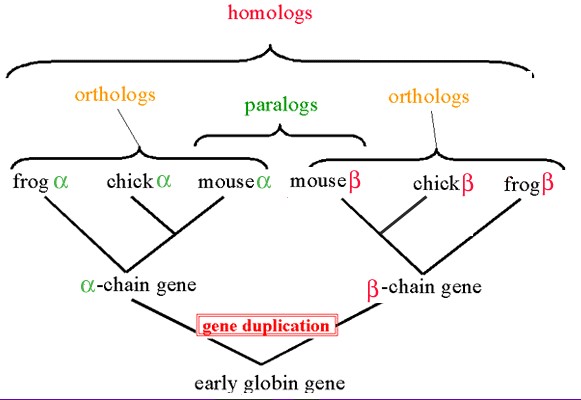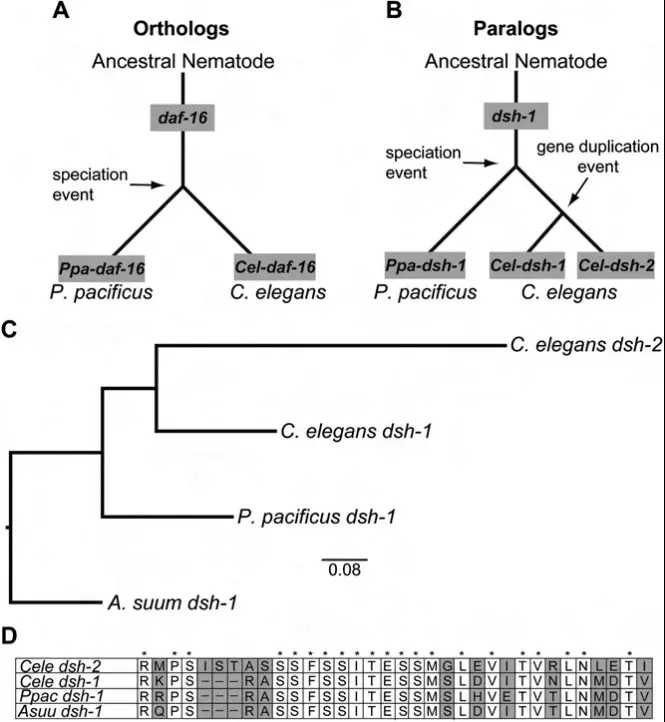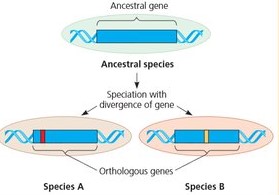Genes are the blueprints of life, guiding the development and functioning of all living organisms through their encoded instructions. Among the myriad types of genes, orthologous and paralogous genes stand out for their roles in the evolution and diversification of species. These genes, though similar, follow distinct paths of development and have different implications for the genetic makeup of organisms.
Orthologous genes are those found in different species that evolved from a common ancestral gene following speciation, thereby retaining the same function across species. Paralogous genes, on the other hand, arise from gene duplication within the same organism, leading to genes that may evolve new functions. Understanding the difference between these two types of genes is crucial for deciphering evolutionary relationships and the functional architecture of genomes.
The exploration of orthologous and paralogous genes opens a window into evolutionary biology, offering insights into how species evolve and adapt. By examining the formation processes, functional implications, and research applications of these genes, scientists can trace the evolutionary history of life on Earth and uncover the molecular underpinnings of biodiversity.

Gene Basics
Definition and Function
Genes are fundamental units of heredity in living organisms. Think of them as instruction manuals that determine the physical and biochemical traits of an organism. Located on chromosomes, these DNA sequences dictate everything from eye color to susceptibility to certain diseases. Each gene encodes for a specific protein, leading to the expression of a particular trait when the protein is synthesized in the body’s cells.
Evolutionary Significance
The evolution of genes is a cornerstone of biological diversity. Through processes such as mutation, selection, and genetic drift, genes change over time, contributing to the variety of life forms on Earth. These evolutionary changes allow species to adapt to their environments, leading to the survival and reproduction of the fittest traits. The diversity we observe in the natural world, from the multitude of species to the vast array of ecosystems, is largely the result of genetic variation and evolution.
Orthologous Genes
Definition
Orthologous genes are those found in different species that originated from a common ancestral gene after a speciation event. This means that these genes were separated by the division of a single species into two or more genetically distinct ones. Despite being in different species, orthologous genes retain the same function, illustrating a shared evolutionary heritage.
Formation Process
The formation of orthologous genes is directly tied to speciation – the process by which new, genetically distinct species evolve. When a species divides into two or more separate species, the genes they carry can diverge while still maintaining their original functions. This divergence occurs over millions of years, with orthologous genes serving as markers of these evolutionary splits.
Functional Implications
Orthologous genes play crucial roles in the biology of species, often retaining similar functions across different organisms. For example, the gene for eye development in humans is closely related to the gene that directs eye development in fruit flies. This functional similarity allows scientists to study simple organisms to understand complex biological processes in humans.
Research Applications
Orthologous genes are invaluable in comparative genomics and evolutionary biology. By comparing these genes across species, scientists can reconstruct evolutionary timelines and relationships. Additionally, understanding the function of orthologous genes in model organisms helps in the development of medical treatments and drugs, as these genes often have counterparts in humans with similar functions.
Paralogous Genes
Definition
Paralogous genes result from gene duplication within the same organism, giving rise to two or more copies of the original gene. Unlike orthologous genes, paralogs can evolve new functions or specialize in particular tasks, increasing the genetic toolkit of an organism.
Formation Process
The journey of paralogous genes begins with gene duplication, a process where a gene is copied within an organism’s genome. This duplication can occur through various mechanisms, including errors during DNA replication or as a result of chromosomal rearrangement. The resulting copies, or paralogs, then have the freedom to evolve independently within the same organism.
Functional Divergence
Over time, paralogous genes often undergo functional divergence, a process where these genes evolve different functions or specialize in particular aspects of their original function. This divergence enriches the organism’s genome, allowing it to adapt to new environments, challenges, or opportunities. For instance, a gene originally involved in detoxifying one substance may duplicate, with the copy evolving to detoxify a different substance, thereby broadening the organism’s ability to survive in varied conditions.
Research Applications
Paralogous genes have significant applications in genetic engineering and functional genomics. By studying the diverse functions and regulation of paralogous genes, scientists can manipulate these genes for various purposes, such as improving crop resistance to pests or diseases, developing new pharmaceuticals, or understanding the genetic basis of diseases. Their ability to take on new functions makes paralogous genes a dynamic field of study within genetics and biotechnology.

Key Differences
Genetic Origin
The roots of orthologous genes lie in speciation — when a single species evolves into two or more genetically distinct species. These genes share a common ancestor and typically maintain similar functions across species. In contrast, paralogous genes originate from gene duplication within the same organism. This process gives rise to gene copies that can evolve independently, potentially acquiring new functions or specializing in different tasks.
Evolutionary Paths
Orthologous and paralogous genes tread different evolutionary journeys. Orthologous genes diverge following a speciation event, evolving along the separate evolutionary paths of the new species. Their evolution is largely parallel to the speciation process itself. On the other hand, paralogous genes evolve within the same organism, following gene duplication. Their evolutionary paths are more about diversification within a species, leading to an increase in genetic complexity and functional versatility.
Functional Roles
While orthologous genes usually maintain the same basic function across different species, reflecting their shared evolutionary history, paralogous genes often diverge in function after duplication. This divergence allows organisms to develop new abilities or refine existing ones, contributing to their adaptation and survival. The study of these genes illuminates the dynamic nature of genomes and the evolutionary processes that drive functional innovation and complexity.
Impact on Biodiversity
Both orthologous and paralogous genes are key players in the tapestry of biodiversity. Orthologous genes underline the common heritage and functional similarities among diverse species, while paralogous genes contribute to the unique features and adaptabilities within a single species. Together, they provide the genetic versatility necessary for the evolution of new species and the adaptation of life to Earth’s myriad environments.
Case Studies
Comparative Genomics
Comparative genomics relies heavily on the study of orthologous and paralogous genes to trace the evolutionary history of life. For example, the comparison of orthologous genes between humans and chimpanzees has shed light on the genetic differences contributing to human-specific traits. Similarly, studying paralogous gene families in plants has helped scientists understand how new functions evolve in response to environmental challenges.
Medical Research
In medical research, understanding the nuances between orthologous and paralogous genes can be pivotal in identifying disease mechanisms and developing new treatments. For instance, orthologous gene comparisons across species have facilitated the identification of genes involved in genetic disorders. Paralogous genes, with their potential for functional divergence, offer targets for drug development, especially when one paralog is involved in disease while another is not.
Challenges in Classification
Gene Conversion
Gene conversion is a process where genetic material is transferred between homologous sequences, potentially obscuring the distinctions between orthologous and paralogous genes. This phenomenon can complicate the accurate classification of genes, especially when gene conversion occurs between paralogs, making them appear more similar than they are due to their evolutionary history.
Limitations of Current Methods
Despite advances in genomics, accurately classifying genes into orthologous and paralogous groups remains challenging. Limitations in current methods stem from the complexity of evolutionary processes, including gene loss, horizontal gene transfer, and the aforementioned gene conversion. These factors can muddy the evolutionary histories of genes, complicating their study and classification.
Future Directions
Advances in Technology
The future of gene classification and understanding is bright, with technological advancements poised to offer new insights. Technologies such as CRISPR for precise gene editing, advanced sequencing methods for greater genomic clarity, and computational models for predicting gene function and evolution, promise to enhance our understanding of orthologous and paralogous genes.
Implications for Evolutionary Biology
A deeper understanding of orthologous and paralogous genes could fundamentally reshape evolutionary biology. Insights into how genes evolve, diverge, and acquire new functions could provide a more nuanced understanding of evolution, species diversity, and the mechanisms that underlie the adaptability of life on Earth. This knowledge not only enriches our comprehension of the natural world but also informs conservation strategies, medical research, and biotechnology applications.

Frequently Asked Questions
What are orthologous genes?
Orthologous genes are genes in different species that originated from a common ancestor through speciation events. These genes generally maintain the same function across species, making them vital tools for understanding evolutionary relationships and functional biology.
How do paralogous genes form?
Paralogous genes result from gene duplication events within the same organism. This process allows for the creation of gene copies that can evolve new functions or diversify existing ones, contributing to the complexity and adaptability of organisms.
Why are these gene types important in evolutionary biology?
Orthologous and paralogous genes are crucial in evolutionary biology because they help scientists understand how species diverge and adapt over time. By comparing these genes across different organisms, researchers can reconstruct evolutionary histories and identify genes that have played a key role in the development of unique traits.
Can orthologous and paralogous genes indicate evolutionary distance?
Yes, orthologous and paralogous genes can be used to estimate evolutionary distances between species. Orthologs, by reflecting speciation events, can help determine the time since divergence from a common ancestor. Paralogs, through their duplication history, provide insights into gene family expansions and the evolutionary pressures faced by an organism.
Conclusion
The distinction between orthologous and paralogous genes is more than an academic curiosity; it is a fundamental aspect of understanding life’s diversity and complexity. These genes not only illuminate the evolutionary pathways that species have taken but also highlight the dynamic nature of genomes, which are constantly being reshaped by evolutionary forces. By decoding the history and function of these genes, scientists can piece together the puzzle of life’s evolutionary history.
Ultimately, the study of orthologous and paralogous genes is a testament to the power of genetics in uncovering the secrets of biology. As research techniques advance, our understanding of these genes will deepen, offering new perspectives on the mechanisms of evolution, the origins of biological diversity, and the interconnectedness of all living things.

